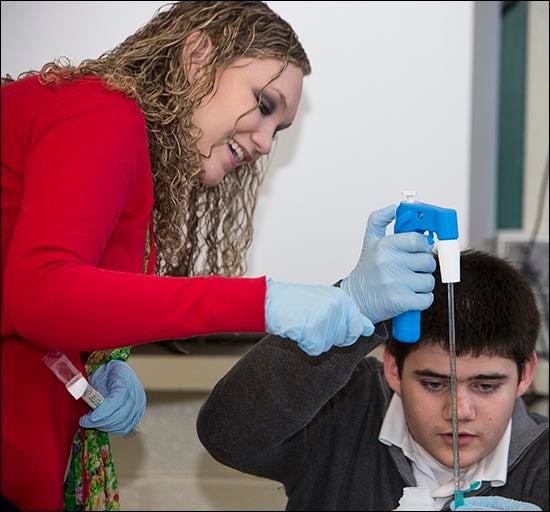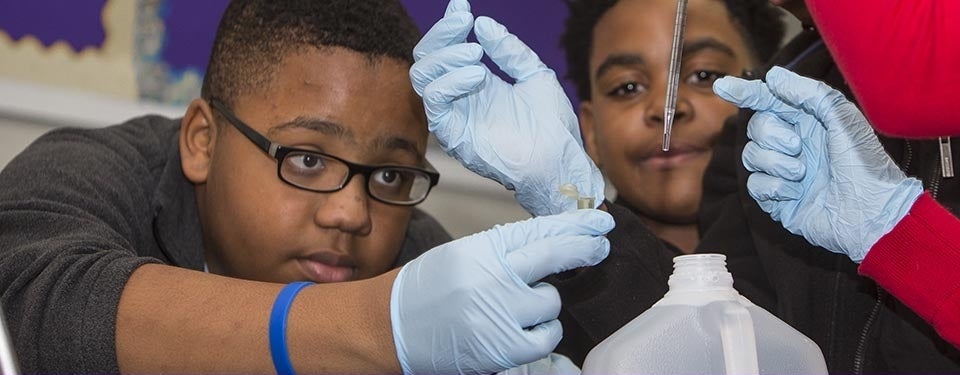BACKYARD BOTANISTS
Education grad leads middle schoolers in conducting nature research
Eighth-graders at C.M. Eppes Middle School hope to find out if a backyard weed actually contains some beneficial ingredients.
Their teacher, Jennifer Stalls, an East Carolina University alumna and graduate student in the College of Education, brought the real-world research question to her science classes as a participant in the Kenan Fellows Program for Curriculum and Leadership Development.
Stalls is one of 42 educators from across North Carolina who completed a five-week summer research experience and two weeks of professional development as part of the annual program.

Jennifer Stalls guides middle school student Christian Wolf, seated, in conducting experiments. Stalls engaged her science class in real-world research as part of her work in the Kenan Fellows Program for Curriculum and Leadership Development.
Stalls worked in the genomics and microbiology lab at the N.C. Museum of Natural Sciences with mentor Dr. Julia Stevens, who is studying the symbiotic relationship between invasive plants and bacteria in nitrogen fixing. The process is needed to convert gaseous nitrogen into forms that can be used by living organisms.
Stalls created a curriculum for her students to contribute to Stevens’ research by studying regional invasive species that could potentially replenish bacteria in crop fields.
Farmers often rotate cotton, corn or wheat with legumes to replenish nitrogen in preparation for the next crop. Stevens found that dandelions can provide the same benefit as peas or beans.
“If the kids can potentially find another weed that is similar to dandelions that can do the same thing, it’s brand new information that no one has discovered,” Stalls said.
Students will discuss the benefits of symbiotic relationships and what that means for the environment. Stewardship plays a big role in the project. The unit also taps into math skills and social studies, including George Washington Carver’s discovery of crop rotation.
“They get the idea that they can be the next George Washington Carvers, that they could discover something that could revolutionize agriculture in North Carolina or the world,” Stalls said.
For the research, students pulled weeds from Eppes’ school yard to take back to the science lab. They separated the soil from the roots, which were sterilized with bleach and distilled water to prepare their experiments.

Jamaya Heath, left, and Precious Wallace of C.M. Eppes Middle School check results of scientific procedures as part of research led by ECU alumna Jennifer Stalls. Students divided into teams to complete different steps in the process.
Among the discoveries students are making is the notion that they like science.
“I like that you can make so many things, so many discoveries with science. I like the medicine part of science,” said student Virginia Rahilly.
About 75 students in three of Stalls’ four classrooms are doing the research; the fourth class is the control group. Students divided into teams to tackle different parts of the project.
Another student, Allana Langley, said she enjoyed going outside to collect the material, which her group is testing for fluorescent property. “I’m ready to see it glow in the dark,” she said.
The students will observe and record growth in petri dishes, and will count bacteria and report back to Stevens, Stalls said.
“They understand that the work they’re doing is something someone really cares about,” she said. “We don’t know what the outcome will be. There is no predicted outcome. We have no idea what the plates will grow.”
Next fall, the students will go to high school already knowing how to collect, prepare and plate samples, make and pour agar – a jelly-like substance used to culture bacteria – and grow and analyze samples, Stalls said.

Ruiko Jacobs, left, and Virginia Rahilly work together on a classroom research project to determine potential benefits of common weeds.
They also are seeing past eighth grade to potential science, technology, engineering and math or STEM careers. “It’s nice for them to be ahead of the curve, to have experienced these techniques and protocols ahead of time,” she said. “They will know how real authentic science works.”
On average, STEM careers pay about 30 percent more and are growing at 1.7 times the rate of non-STEM jobs.
Stalls said her passion for teaching comes from her childhood growing up on a farm in Martin County. She wants to prepare her students to compete with their peers west of I-95 and beyond.
While the students don’t yet know how their project will turn out, that’s part of the fun, said Stalls. “We’ve got a research question, we’re going through the steps to conduct research and we don’t have a conclusion, and that’s OK.
“Ninety percent of science is doing all these things and not figuring out anything except the things we should change with our next experiment,” Stalls said. “It’s the most rewarding and the most challenging thing about science.”
Stalls is one of six ECU alumni in the 2015-16 class of Kenan Fellows. Others and the schools where they teach are: Christopher Clark ’13, Chicod School in Pitt County; Taylar Flythe ’12, Ligon Magnet Middle School in Wake County; Denise Humphries ’93, Chinquapin Elementary School in Duplin County; Amy Kennedy ’07, Beulaville Elementary School in Duplin County; Julianna Martinez-Schultz ’10, Moore Square Magnet Middle School in Wake County.
The Kenan Fellows Program was established in 2000 as the signature K-12 STEM education initiative of the Kenan Institute for Engineering, Technology & Science at N.C. State University. Kenan Fellows are given opportunities for networking, professional growth and leadership development. For more information, visit www.kenanfellows.org.
Pictured below left to right, Christian Morales, Jimmy Zheng, Luke Leong and Luke Daigle complete experiments at C.M. Eppes Middle School, while gaining skills they will carry with them to high school.
